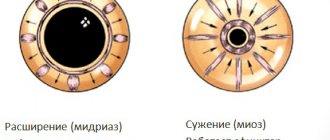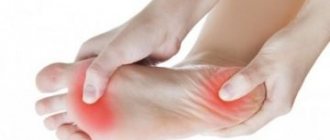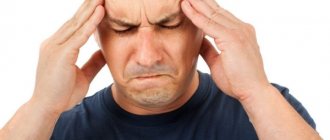Hyperkinetic syndrome is a manifestation of various neuropsychiatric diseases, which is characterized by involuntary movements, inattention, hyperactivity and impulsivity. According to ICD-10, the syndrome is coded F90.
The name of the pathology translated from Latin means “supermovement.” Motor hyperactivity has been known since the Middle Ages. The clinical signs of the syndrome were mentioned in the works of those times, but the corresponding pathological changes in the brain tissue were not identified. Hyperkinesis in the Middle Ages was considered a neurological disorder. Modern scientists have identified a close relationship between the disease and a disorder in the exchange of neurotransmitters in the brain and have studied the pathogenetic basis of the formation of movement disorders.
Pathology has no clear restrictions regarding age and gender. The syndrome occurs predominantly in school-age children, and is much more common in boys than in girls. Patients are absent-minded, inattentive and restless. Movements arise against their will again and again. They commit impulsive actions and get irritated over trifles, which leads to failure at school and negatively affects socialization. Persons with hyperkinetic syndrome often become outcasts from society, have no friends, and do not join the team.
Clinical and morphological forms of the syndrome:
- Tics are sudden short-term stereotypies caused by spontaneous muscle contraction that cannot be controlled or influenced;
- Myoclonus is a short, convulsive, repeated twitching of large muscle groups;
- Chorea - erratic, jerky, irregular movements that resemble normal facial expressions and gestures, but differ from them in amplitude and intensity;
- Ballism - large-scale hyperkinesis affecting the muscles of the arms or legs;
- Tremor - rapid and rhythmic contractions of the muscles of the limbs or head of an involuntary nature, occurring at rest or during voluntary movement;
- Myokymia - unconscious and spontaneous muscle contractions caused by hyperexcitability of the spinal cord;
- Torsion spasm - rotation or twisting of any part of the body caused by chaotic muscle contractions;
- Facial spasm - clonic contractions of facial muscles innervated by the facial nerve;
- Akathisia is a violation of motor functionality with a constant feeling of internal restlessness;
- Athetosis is involuntary and continuous, slow and uncoordinated worm-like movements of the fingers, toes, face, torso, and tongue with speech impairment.
Diagnosis of the syndrome consists of electroencephalography, electroneuromyography, tomography, duplex scanning, and biochemical blood tests. Treatment of the pathology is conservative, individually selected. Patients are prescribed medications from the group of antipsychotics, anticholinergics, valproates, and benzodiazepines. The prognosis of the pathology is favorable with timely provision of medical care. Otherwise, the disease progresses, serious complications develop, which lead to disability and severe mental disorders.
Etiology and pathogenesis
The specific causes of the syndrome are currently unknown. The pathology is based on a violation of neurotransmitter metabolism. Adrenaline, serotonin, acetylcholine and dopamine are complex biologically active substances responsible for information flows between nerve cells. A deficiency of some substances and an excess of others contributes to disruption of the higher and lower functions of the nervous system, and also leads to the development of hyperkinetic syndrome.
Endogenous and exogenous factors provoking the development of the syndrome:
- Endocrinopathies,
- Cerebral palsy,
- Congenital pathologies
- Traumatic injuries
- Metabolic disorders,
- Toxins,
- Infection,
- Pathology of pregnancy,
- Difficult childbirth
- Outbursts of emotions, stress, nervous tension,
- Hereditary predisposition
- Constitutional features,
- Organic brain damage
- Degenerative-dystrophic processes,
- Treatment with certain medications.
Under the influence of these factors, a malfunction occurs in the neurotransmitter system, which ensures the interaction of subcortical and integration structures with motor neurons of the spinal cord. In this case, the regulation of voluntary movements is disrupted. Dysfunction of the extrapyramidal system causes the appearance of hyperkinesis due to the distortion of nerve impulses coming from the motor nuclei of the medulla oblongata to the spinal cord neurons of the same name responsible for muscle contraction. This is how abnormal movements arise.
Diagnostics
Adults who suffer from this disease differ from others in their behavior:
- They are in an alarming state.
- Constantly feel bored or melancholy.
- They often forget about something and do not know how to control time.
- They show unjustified irritability and outbursts of anger.
- They are impulsive and have sudden mood swings.
- They do not know how to organize systematic activities.
- They have low self-esteem.
- They experience difficulties in building relationships.
- They may have problems communicating with others, several marriages.
- They often violate traffic rules.
- They work poorly and often change jobs.
- Fully or partially dependent on psychoactive substances.
Some patients are able to cope with the situation, concentrate and be attentive if they show increased interest in some action or object.
Other patients cannot control themselves and therefore require mandatory drug treatment.
Relatives and friends should carefully monitor the timeliness of taking medications. Because a sick person, due to forgetfulness, may miss a dose or, on the contrary, get too carried away with the medications.
https://feedmed.ru/bolezni/nervnoj-sistemy/giperkineticheskij-sindrom.html
Classification
Etiological classification of the syndrome:
- Primary hyperkinesis is the result of genetically determined idiopathic processes in the central nervous system.
- Secondary hyperkinesis is a manifestation of an underlying disease or injury: head injury, neoplasm, alcoholism, intoxication, infectious encephalitis, circulatory disorders, stroke.
- Psychogenic hyperkinesis is a sign of a mental disorder: hysteria, neurosis, psychosis.
Classification by type of occurrence:
- Spontaneous hyperkinesis, occurring suddenly and involuntarily.
- Actional hyperkinesis, provoked by a certain posture or movement.
- Reflex – a syndrome as a reaction to external stimuli.
- Induced - hyperkinesis appears at the will of the patient and can be restrained by him until a certain moment.
Classification of hyperkinesis by current:
- Permanent - disappearing only in sleep,
- Paroxysmal - appearing episodically and limited in time.
Hyperkinesis can also be fast and slow, occurring when the lesion is localized in the brain stem or subcortical structures.
Therapy with drugs
As experts who study hyperkinetic syndrome note, the treatment of this disorder should be comprehensive. One of its components is the use of medications. With a correct diagnosis, their effectiveness becomes very high. These drugs have a symptomatic effect. They suppress the manifestations of the syndrome and significantly facilitate the development of the child.
Drug therapy should be long-term, since it is important not only to remove the symptoms, but also to consolidate the resulting effect. You should not trust folk remedies, because only a doctor can select the optimal drug and prescribe effective treatment.
Symptoms
The clinical picture of the disease is characterized by polymorphism, varying degrees of severity and prevalence of symptoms.
The first signs of pathology appear in early childhood and are diagnosed somewhat later. In children, hyperkinetic syndrome is manifested by the following initial signs:
- Excessive activity
- Strong excitability
- Inattention,
- Impaired cognitive functions,
- Impatience
- Imbalance,
- Restlessness,
- Anxiety
- Constant movements of arms and legs.
Infants are highly sensitive to external stimuli - noise, light, hypo- and hyperthermia, changes in their usual environment. They are overly active not only during the day, but also in the evenings. Before bedtime, babies resist swaddling, eat poorly, and cannot calm down for a long time. Their sleep is disturbed: it becomes short and intermittent. Patients often wake up due to active movements of their arms and legs. One-year-old babies usually do not sit, do not crawl, and rarely roll over onto their stomachs. They sharply throw their head back or turn it around. They make quick and sweeping, worm-like movements with their hands, often shuddering and closing their eyes.
Sick children 4-5 years old are bothered by twitching of different parts of the body - squeezing the gluteal muscles, twisting the arms and legs in different directions, opening the mouth, as well as vocalisms - coughing, sniffing, grunting. These symptoms occur suddenly, periodically becoming more frequent or weakening. They may disappear at night, but they always worsen before bed. Patients are characterized by delayed speech and psycho-emotional development with preservation of intelligence. Such children do not study in kindergarten themselves and interfere with others. When trying to force them to do something, they show aggression, beat and bite other children and the teacher. Sick children cannot play or spend leisure time in peace. They do not concentrate and prefer physical activity.
Boys and girls are able to restrain themselves. By pacifying their motor restlessness at least for a short time, they begin to feel internal discomfort, tension and anxiety.
Adolescents have the following characteristics:
- Impulsiveness,
- Nervousness,
- Emotionality,
- Intolerance,
- Impressionability,
- Impetuousness,
- Excitability,
- Expansiveness.
Patients constantly interrupt the conversation, interrupt the interlocutor, and cannot listen to him to the end. Questions are answered harshly and often inadequately, which is due to an inability to listen. They behave unmotivated, do unexpected things - run, jump, interrupt a game or conversation. Children with pathology experience difficulties in learning: they have poor memory, handwriting, sound perception and speech are impaired. At the same time, intelligence does not suffer. They are characterized by sudden changes in mood - from aggression and protest to anxiety and sadness. Often depression is caused by intra-family and interpersonal conflicts.
Hyperkinetic syndrome is characterized by rash and unexpected actions of patients. They are aggressive, tactless, rude, and prone to nervous disorders. Patients sleep poorly, have no appetite, and their mood often changes. It is difficult to communicate with them, because their sympathies are short-term, they cannot wait, they need to get everything at once.
Clinical signs of the syndrome in adults are:
- Tiki,
- Tremor,
- Twitching of facial muscles
- Chaotic movements of various parts of the body,
- Impaired gesticulation
- Mimic disorders,
- Speech dysfunction.
Motor acts that develop against the patient’s will are violent. The intensity of clinical signs increases with walking, writing, speech activity, and in states of psycho-emotional stress. Patients can suppress them for a short time.
When making a diagnosis, it is necessary to take into account the age characteristics of patients. Symptoms of a pathology of the cardiac type are: pulsation in the head and neck, tachycardia, hypertension. Hyperkinetic syndrome with a predominance of hypotension is manifested by cephalgia, tinnitus, dizziness, lethargy, blurred vision, and hyperhidrosis.
Clinical manifestations stop by the age of 20, first gradually weakening and then completely disappearing. First, excess mobility goes away, and then attention disorder. If left untreated, the syndrome can lead to antisocial behavior and personal and emotional disorders. Complications of the pathology are severe mental disorders that make a person disabled.
Video: example of a patient with hyperkinesia
Establishing diagnosis
Since hyperkinetic syndrome is idiopathic in nature, diagnosis is made by excluding secondary forms associated with pathologies of the endocrine system and tumors.
Diagnostic measures include computed tomography, magnetic resonance imaging of the brain and laboratory tests.
Any identified hyperkinetic syndrome in a patient under fifty years of age indicates that hepatolenticular degeneration is absent. This can be confirmed by testing the blood for the presence of ceruloplasmin, as well as examining the cornea for the presence of a Kayser-Fleischer ring.
Timely diagnosis makes it possible to identify this pathology, which poses a danger to the patient’s life, and begin prompt treatment.
There are two types of syndrome. Hypotonic-hyperkinetic syndrome is expressed by amyostatic signs, which are combined with small-amplitude tremor.
Pathologies of the oculomotor system occur, which can be divided into groups: transient - double vision and persistent - violation of coordinated eye movements, convergence, nystagmus, anisocoria. The degree of impairment in this case is manifested by mild hemiparesis, and nerve paralysis is also observed, causing hemihypesthesia.
Hyperkinetic cardiac syndrome is the occurrence of certain types of VSD symptoms.
Modern Western medicine denies the existence of VSD as a separate disease, although in the countries of the former Soviet Union it is recognized as an independent disease.
However, it is generally accepted that vegetative-vascular dystonia is a combination of various symptoms. This type of syndrome is caused by increased activity of beta-1 adrenergic receptors of the myocardium due to sympathadrenal predominance.
It is characterized by a hyperkinetic type of blood circulation and has the following symptoms:
- increased stroke and cardiac output, which greatly exaggerate the metabolic needs of cardiac tissue;
- increasing the speed of blood pumping to the heart;
- the frequency of compensatory reduction of the entire peripheral resistance of the vascular system increases.
Differential diagnostics
Hyperkinetic syndrome must be differentiated from other neurotic forms. In this case, some problems may arise due to the addition of neurotic symptoms during the development of the disease.
Among the distinctive symptoms of neurotic hyperkinesis are the following:
- formation or progression of hyperkinesis due to exposure to a traumatic factor;
- hyperkinesis usually occurs in the presence of others;
- unnatural expression of postures and movements;
- hyperkinesis is variable and changes very quickly;
- vegetative reactions and neurotic indicators are clearly expressed;
- muscle tone remains unchanged.
Diagnostic procedures
Diagnosis of hyperkinesis is based on symptomatic data, characteristics of the neurological status, medical history and examination results.
The examination of patients with hyperkinetic syndrome begins with a medical examination. Neurologists determine the type of hyperkinesis, concomitant neurological disorders, mental disorders, and level of intelligence.
Instrumental and laboratory diagnostic methods:
- EEG is an assessment of the bioelectrical activity of the brain, which allows us to exclude epilepsy.
- ENMG is performed to detect muscle pathology with impaired synaptic transmission.
- Tomographic examination of the brain is a method for detecting organic brain damage, tumors, ischemia, hematoma, and inflammation.
- MRI of cerebral vessels and duplex scanning allow assessment of cerebral blood flow.
- Cerebral angiography is X-ray visualization of cerebral vessels.
- ECG - identifying signs of myocardial ischemia.
- Biochemical blood test - determination of hyperkinesis of metabolic or toxic origin.
- Measuring blood pressure and pulse are indicators of the performance of the cardiovascular system.
- Medical genetic counseling is carried out to determine hereditary predisposition to hyperkinesis.
Since hyperkinetic syndrome is a manifestation of various mental and somatic pathologies, it is necessary to take all recommended measures to find out the etiology of hyperkinesia. After diagnosis, the patient is prescribed appropriate therapy.
Video: specialist on diagnosing hyperkinesia
Causes of hyperkinetic syndrome in adults and its therapy
Hyperkinetic syndrome (hyperkinesis) is a neurological pathology that manifests itself in the form of involuntary contractions of certain muscle groups.
The disease has numerous clinical forms. The exact cause of the pathology is unknown; hyperkinetic syndrome has a multifactorial etiology.
Most often, the disorder is observed in childhood, but can also develop in adults.
The group of hyperkinesis in neurology includes a large number of pathological phenomena characterized by involuntary muscle activity. Pathology can be of either congenital or acquired origin.
Causes
The activity of human muscles is regulated by the extrapyramidal system. This is a set of brain structures responsible for controlling movements, maintaining tone, and certain postures. Impaired conduction of nerve impulses in the system leads to the formation of hyperkinetic syndrome in adults.
Provoking factors:
- disorders of cerebral blood supply;
- pressure on the nerve centers due to vasodilation;
- cerebral paralysis;
- endocrine diseases;
- traumatic brain injuries;
- infectious diseases;
- congenital defects and developmental anomalies;
- pathological neoplasms;
- exposure to toxic substances and intoxication.
In some patients, hyperkinesis occurs when the nervous system is damaged due to long-term use of drugs, against the background of strokes, heart attacks, and diseases of the digestive system. Intense attacks can be provoked by psycho-emotional tension, stress, and extreme situations.
Classification and symptoms
Hyperkinesis is divided depending on the localization of the pathological process and the degree of intensity. Determining the type of disorder is an important diagnostic criterion that influences the choice of treatment.
Depending on the clinical picture, the following types are distinguished:
- Choreic (choreiform). Characterized by abnormal movements of the limbs or facial muscles. It can have both congenital and acquired origin. Often occurs against the background of brain injuries, cancer, rheumatism, and degenerative processes. Lesions of the facial muscles are usually unilateral.
- Athetoid. Characterized by involuntary flexion of the toes or hands, facial spasms, and convulsions. In the absence of therapy, the mobility of the joints is impaired, as a result of which the patient is partially immobilized.
- Hemifacial. It is a hyperkinesis that occurs in the facial muscles. The nature of the manifestations is different. The facial muscles are predominantly affected. Sometimes there is involuntary closure of the eyelids, and the lower jaw twitches. Spontaneous movements of the tongue and lips are noted.
- Shaking. It is characterized by the involuntary occurrence of tremor, in which a separate muscle area is involved in the process. May indicate an early stage of Parkinson's disease.
- Ticotic. It is considered the most common form of the syndrome. In most cases, thyroid hyperkinesis appears due to damage to the central nervous system due to trauma, poisoning, and infectious pathologies. It occurs against a background of strong emotional arousal, as a reaction to intense stimuli. A nervous tic is an arrhythmic hyperkinesis with low amplitude that occurs in a single muscle. The peculiarity is that a person is able to suppress involuntary movement for some time.
- Myoclonic. It is a paroxysmal hyperkinesis, characterized by point contractions of muscle fibers. Localized mainly in the muscles of the face and lower extremities. Pathology occurs due to congenital anomalies.
- Slow. Characterized by decreased tone and muscle spasms. Due to the development of the pathological process, the patient takes an unnatural position. Because of this, there is a threat to the musculoskeletal system.
- Cardiac. It is a form of VSD in which the cardiovascular system is involved in the pathological process. It is characterized by the development of hyperkinesis in the left ventricle of the heart, as a result of which intense tachycardia develops. The pathology is accompanied by increased pulsation in the temples, in the area of the carotid artery. The occurrence of cardiac hyperkinetic syndrome may indicate the initial stage of myocardial infarction.
The clinical picture of hyperkinesis includes a wide range of symptomatic manifestations, which include:
involuntary movements of the limbs;
- tremor;
- numbness and muscle spasms;
- feeling of pulsation in large vessels;
- twitching of small muscle groups;
- involuntary movements of the tongue and lower jaw;
- closing of eyelids;
- intense cramps on one side of the body;
- decreased overall muscle tone;
- impaired coordination of movements;
- violations of fine motor skills of the hands;
- taking unnatural poses.
Therapeutic measures
It is important to note that hyperkinetic syndrome can be either primary or secondary. When diagnosing, it is necessary to determine the cause of the disorder, since only its elimination will relieve the patient of symptoms. Various methods are used to treat hyperkinesis, the main one of which is taking medications.
Drug therapy
Medicines are prescribed taking into account the individual characteristics of the patient and the specific clinical picture. For therapeutic purposes, drugs with sedative and anticonvulsant effects are used.
In some cases, it is impossible to completely cure the pathology. Then therapy is aimed at improving the patient’s condition, reducing the frequency of attacks, reducing their intensity, and preventing complications.
The following groups of drugs are used for medicinal purposes:
- Anticholinergics. The action is aimed at inhibiting nervous processes in muscles by reducing the activity of acetylcholine. They are most effective for hyperkinesis accompanied by spasms, tremors, and torsion dystonia. A common representative of this group is Trihexyphenidyl (Cyclodol, Parcopan, Alo-Trihex).
- Dopa preparations (Dihydroxyphenylalanine). The action is aimed at improving dopamine metabolism. Intended for the treatment of torsion dystonia.
- Neuroleptics. Prescribed to stop intense nerve impulses. They are used for facial spasms, athetoid, choreic, and torsion hyperkinesis.
- Benzodiazepines. They are characterized by pronounced anticonvulsant and relaxing effects. Patients with hyperkinetic syndrome are prescribed drugs based on Clonazepam. These include Clonotril and Rivotril.
For hyperkinesis, treatment with homeopathy may be prescribed. This method has many positive reviews from doctors and patients. Use is allowed only with the approval of the treating neurologist.
Folk remedies
For the purpose of auxiliary therapy, alternative medicine methods are used. Folk remedies are used that have a sedative and relaxing effect. Water procedures, baths with the addition of sea salt, and infusions of sedative herbs (mint, lavender) have a positive effect.
Infusions prepared from oat grains have a good effect for hyperkinesis. It is necessary to pour 0.5 kg of grains into 1 liter of water and cook over low heat. The resulting liquid is decanted and honey is added to it. You should drink the medicine 1 glass.
For hyperkinetic syndrome, chamomile decoctions, tea with mint leaves, and lemon balm are useful. Infusions of rose hips and motherwort are characterized by positive effects.
Prognosis and prevention
Hyperkinesis is not life-threatening for the patient. However, the regular occurrence of manifestations of the syndrome in front of other people is the cause of psychological disorders and social maladjustment of the patient. In severe cases, hyperkinesis leads to difficulty moving and the inability to self-care.
With proper treatment, it is possible to eliminate the cause of the pathology and its manifestations. This allows the patient to lead a full life without any restrictions. Compliance with preventive measures improves the quality of life and reduces the risk of complications.
Preventive measures include:
- exclusion of traumatic factors;
- rejection of bad habits;
- proper rest and sleep;
- physiotherapy;
- water procedures;
- sanatorium-resort recovery;
- reduction of stress loads.
(1 5,00 of 5) Loading...
Source: https://ProSindrom.ru/psychopathology/lechenie-giperkinezov-u-vzroslyh.html
General therapeutic measures
Treatment of the pathology is conservative, medicinal. Patients are prescribed the following medications:
- Levodopa preparations – “Sinemet”, “Tremonorm”, “Dwellin”;
- Muscle relaxants – “Cyclodol”, “Baclofen”, “Mydocalm”;
- Anticonvulsants - Clonazepam, Finlepsin;
- Sympatholytics – “Reserpine”, “Normatens”;
- Diuretics – “Diacarb”, “Lasix”;
- Antipsychotics - “Haloperidol”, “Sonapax”, “Aminazine”;
- Psychostimulants – “Phenamine”, “Ephedrine”, “Cathinone”;
- Antidepressants - Amitriptyline, Fluoxetine, Nialamid;
- Neuroprotectors – “Cerebrolysin”, “Nootropil”, “Phesam”;
- Vitamins – “Neurovitan”, “Neuromultivit”;
- Vascular agents – “Trental”, “Cavinton”, “Vinpocetine”;
- Nootropics – “Piracetam”, “Cerebrolysin”, “Pantogam”;
- Antihypoxants – “Actovegin”, “Cinnarizine”, “Cortexin”;
- Sedatives – “Persen”, “Tenoten”.
Physiotherapy significantly improves the prognosis of pathology. Patients are prescribed hydrotherapy, exercise therapy, acupuncture, and electrophoresis. Gymnastics makes the child much calmer and more balanced, having a beneficial effect on the entire body. General strengthening procedures - hardening, baths, rubdowns, massage - have a good effect.
In addition to medication, psychotherapy, the main methods of which are suggestion and persuasion, has a positive effect on the condition of patients. Persons without signs of pronounced psychoneurological disorders easily adapt to society and subsequently live a full life. This is facilitated by close interaction and contact between the patient and his family with psychologists and teachers. All kinds of psychological training and sessions with psychotherapists are usually combined with the use of certain medications. Complex treatment and family psychotherapy contribute to the rapid recovery of patients.
Diet therapy is primarily indicated for children. It is necessary to exclude products with preservatives and dyes from the diet. The menu should include dishes made from fresh vegetables and fruits, cereals, herbs, lean meat, and whole grain bread.
Traditional medicine also helps to cope with the disease. Patients are shown warm baths with decoctions of medicinal herbs or sea salt. It is useful to take an infusion of oats, a decoction of violet, mint and motherwort, and mumiyo with honey and milk internally. Walking barefoot on the ground has a beneficial effect on the child's mental state.
In particularly severe cases, surgery is indicated. In the presence of facial hemispasm, decompression of the facial nerve on the affected side is indicated, which consists of exposing the nerve trunk and highlighting the site of damage. Stereotactic pallidotomy and electrical stimulation are used for various manifestations of hyperkinesia. During the operation, the area of tissue that provokes involuntary muscle spasm is destroyed.
Where to contact
If parents suspect that their child has a similar condition, consultation with a psychiatrist is necessary.
Only a specialist, observing the child’s behavior and character, can make an accurate diagnosis.
Signs indicating the presence of a disease cannot be isolated, that is, symptoms that periodically recur for at least 6 months are considered diagnostically significant.
In order to identify the presence of pathology, the doctor uses the following methods:
- conversation (often the child does not admit the presence of any of the symptoms, and adults, on the contrary, exaggerate them);
- assessment of behavior in a child’s natural environment (kindergarten, family, school, etc.);
- modeling of life situations to assess the child’s behavior in them.
Forecasting
Hyperkinetic syndrome does not threaten the patient's life and has a favorable prognosis. The demonstrative nature of the pathology causes hostility towards the patient among those around him. This depresses his psychological state and completely disadapts him. If hyperkinesis is severe, voluntary movements become difficult, self-care is impaired, and complete disability occurs. Depending on the etiopathogenetic factors of the syndrome, its outcome is determined. In the absence of therapeutic measures, the disease progresses, patients cannot care for themselves, move independently, or even swallow. In the most advanced stages, dementia develops. In this case, patients require hospitalization and treatment in a psychiatric hospital.
To avoid the development of hyperkinetic syndrome, experts recommend promptly treating mental and somatic diseases, avoiding conflict situations, seeing a psychologist if necessary, leading a healthy lifestyle, and engaging in feasible sports.
Treatment of hyperkinetic syndrome – PsychologistInfo
Hyperkinetic syndrome (hyperkinesis) is a neurological pathology that manifests itself in the form of involuntary contractions of certain muscle groups.
The disease has numerous clinical forms. The exact cause of the pathology is unknown; hyperkinetic syndrome has a multifactorial etiology.
Most often, the disorder is observed in childhood, but can also develop in adults.
The group of hyperkinesis in neurology includes a large number of pathological phenomena characterized by involuntary muscle activity. Pathology can be of either congenital or acquired origin.












